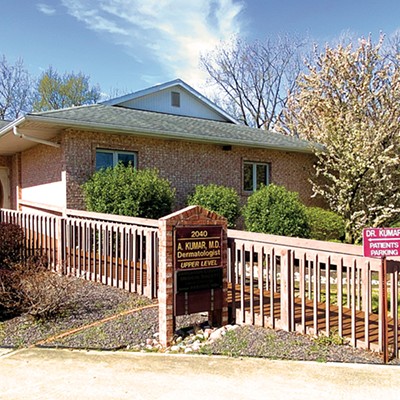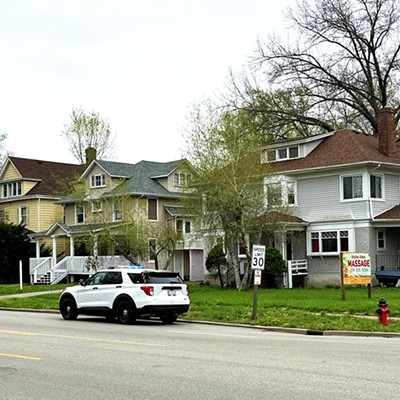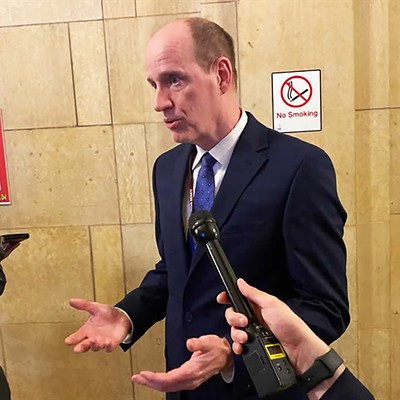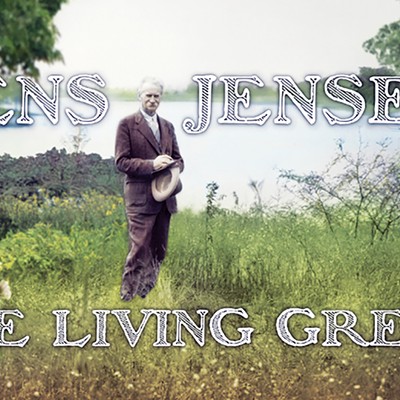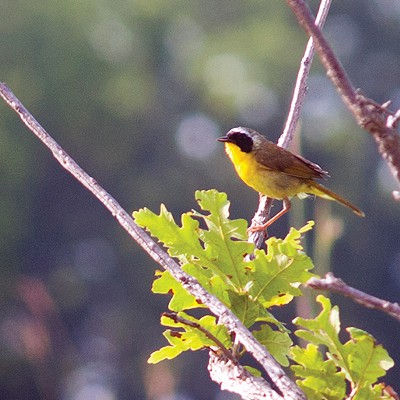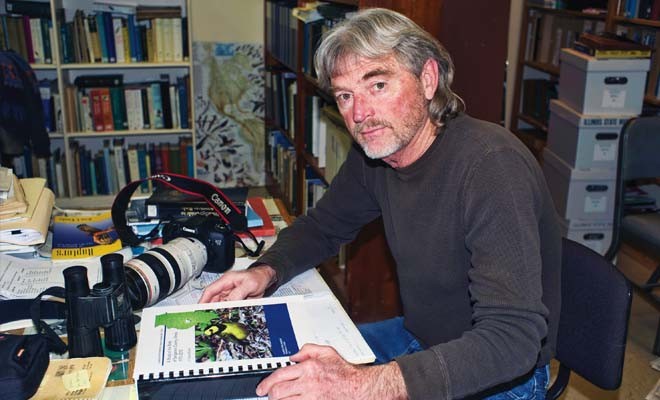
Birds are at once well-known companions and elusive visitors. Many embark on enormous journeys, bringing with them the songs of spring and insights into the health of our surroundings. They belong to everyone and to no one, and it is no easy task knowing their numbers. What bird populations can be found in Sangamon County? What might they have to tell us?
David Bohlen, assistant curator of zoology at the Illinois State Museum, has spent 40 years trying to answer these questions, as readily evidenced in the stacks of folders and files that have accumulated in his office over the course of his research. “I started out just wanting to write everything up, to have it all in one spot. And then I started thinking how we don’t have much information on natural history in Sangamon County. This would at least be a chunk.” This “chunk” was released in January by the Illinois State Museum in a two-volume report called A Study of the Birds of Sangamon County, Illinois 1970–2010 and is the debut publication of its new Research eSeries.
For an average of more than 319 days a year for 40 years, Bohlen has visited numerous sites in Sangamon County, returning again and again to diverse habitats where he recorded 355 species, personally confirming each sighting. “I saw them or heard them or picked them up dead off the road. None were from lists from someone else,” he explains.
The resulting publication is not meant to be a bird identification guide. Bohlen’s goal has been to document the year-long residents, those that breed here and those that pass through Sangamon County as they follow migratory routes. Through the compilation of such data as arrival and departure dates, habitat changes, and singing dates, he has sought to discover trends and correlations, noting various species’ movements in tables and graphs. Volume 2 is filled with photographic documentation of the county’s birds as they go about their lives upon water, within trees and grasses, and in flight. While a few of the photographs are somewhat fuzzy representations of birds in action, most are spectacular portraits of species that many of us have never encountered.
To care about the birds of Sangamon County, we must know them and their needs. By presenting studies of existing species and ongoing environmental processes, Bohlen provides research that will, tomorrow, become insight into our past. At the same time, it triggers thoughts of what the future may hold. This is no static story.
“During my study, a lot of things started changing,” he states, and the opening of Bohlen’s publication foreshadows his findings. In it he includes a dedication “to the native species of birds that have survived in Sangamon County.”
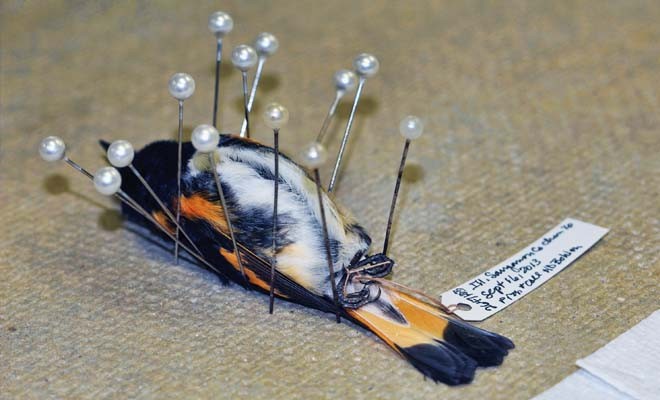
Building on a legacy
“[S]eek another bird…and another…and still another. Soon there will grow an acquaintance-list of birds which is one of the finest satisfactions of this workaday world.” Virginia S. Eifert, Birds in Your Backyard, 1941
Bohlen states that very little was known about the birds of the county prior to his study, but he notes that a list of 272 species did exist dating from before 1970. The list was primarily compiled by Virginia Eifert and Bill Robertson, and Eifert would go on to publish introductions to many birds of Sangamon County and other parts of Illinois in the Illinois State Museum publications, Invitation to Birds and Birds in Your Backyard.
Eifert joined the staff of the Illinois State Museum in 1939, and she would become a noted naturalist and author, producing 18 volumes of writing and hundreds of articles on natural history subjects. Although Bohlen notes that Eifert’s list of birds is somewhat anecdotal, through her efforts we begin to understand the importance of documenting our present-day species. Some of her descriptions now read like a remembrance.
Of the Northern Bobwhite, Eifert writes: “The bobwhite fits into the Illinois scene…the running birds leap into the air and glide on bowed wings into the grass; the bobwhite whistles, and the countryside acquires new satisfaction.” How long has it been since we have heard the “Bob-WHITE” call, familiar in childhood summers? And what has become of the Loggerhead Shrike that Eifert refers to as a common summer resident in central Illinois that “sings like a catbird or a mockingbird, with innumerable mimickings, grace notes, and original melodies rendered in a powerful tootling voice”?
With Bohlen’s research, what may have been a vague and unsettling awareness becomes confirmed fact. Northern Bobwhite numbers have dwindled in Sangamon County, and the Loggerhead Shrike is one of the species of which Bohlen writes, “It is greatly lamented that the following interesting and unique species seemingly disappeared or were extirpated as breeders as well as migrants.” Others included in this list of 15 species are the Upland Sandpiper, Whip-poor-will, Brown Creeper, Bewick’s Wren, Cerulean Warbler, and the Western Meadowlark.
Bohlen refers to his research as baseline data – a quiet, unobtrusive term for a wake-up call. He notes that certainly things have changed since Eifert’s time, but he adds that he did not have to look at the pre-1970s information to recognize species disturbances. “During my study, a lot of things started changing,” he states.
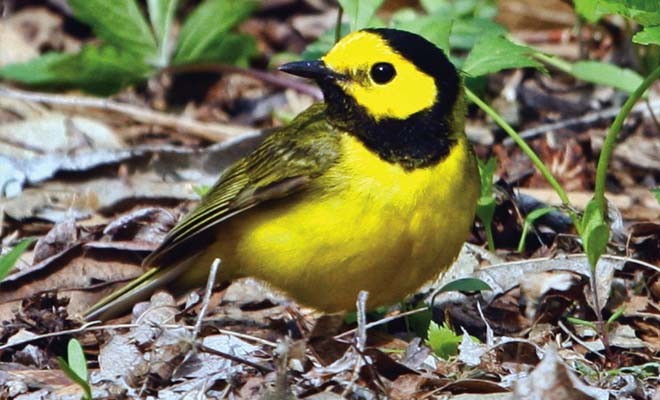
Sentinel species
“In nature nothing exists alone.” – Rachel Carson, Silent Spring, 1962.
Well into the 20th century, miners brought canaries into coal mines as an early-warning device since toxic gases would affect the birds first, allowing time for escape. The notion of the “canary in a coal mine” has become an enduring example of the advance notice of environmental disruptions offered to us by other species.
Birds are an especially important as a sentinel species – a species that stands guard for the rest of us. Not only are they more susceptible to potentially dangerous conditions, we are also more likely to take notice of their losses. They have become for us symbols of freedom and peace and can provoke powerful emotions, sparking action on their behalf – perhaps before we may recognize a need to act for our own protection.
This was the case when Rachel Carson published in 1962. The book opened with “A Fable for Tomorrow” in which Carson described an imaginary spring devoid of birds and their accompanying songs of the season. “No enemy action had silenced the rebirth of new life in this stricken world. The people had done it themselves,” she wrote. The book went on to present scientific information about the threat to numerous species from the use of DDT as a form of pest control. But it was the imagined spring without birds that set off a public firestorm and helped prompt President John F. Kennedy to take action. During an Aug. 29, 1962, press conference, he confirmed that the government was looking at the situation. “I think particularly, of course, since Miss Carson’s book,” he stated. Eventually, the use of DDT would be banned.
We might know instinctively that threats to birds are likely to threaten us as well. However, decisions must be based on data and not intuition. Bohlen has discovered that 111 Sangamon County bird species are in decline, and the table within the report titled “Species Status Change in Sangamon County (1970-2006)” offers associated findings as to why.
No marsh habit; urbanization; habitat loss. These notations appear again and again.
Bohlen asks us to consider that in 1830 there were 15 people per square mile in Sangamon County. By 2008, the population per square mile had increased to 222. In addition, 83 percent of unpopulated land was in agriculture. “Every year there is less and less habitat for native plants and animals in Sangamon County simply because there is less area that has not been converted to human use,” he states.
But beyond the aesthetic loss to human society, do lost habitat and lost species really affect us? Can this be likened to a warning?
A report titled The State of the Birds, United States of America, 2009, which was produced through a collaboration of numerous government agencies and private organizations, uncannily mirrors Bohlen’s Sangamon County findings. It, too, provides results from a 40-year study and reveals “alarming declines for many of our most common and beloved birds.” The report goes on to offer reasons why we should care, stating: “Birds are bellwethers of our natural and cultural health as a nation – they are indicators of the integrity of the environments that provide us with clean air and water, fertile soils, abundant wildlife and the natural resources on which our economic development depends.”
And with Bohlen’s research we can no longer comfort ourselves with the idea that the bird species we no longer see in our immediate area, within our own backyards, are perhaps living comfortably somewhere – being taken care of by someone.
The ban on DDT provides an example of the success that can follow increased awareness and a willingness to act. Since DDT slowly accumulates in each stage of the food chain, the pesticide nearly exterminated many of our country’s birds of prey. Bohlen now lists 10 species that have rebounded due to “DDT recovery” since the start of his study. These include the Red-shouldered Hawk, the Great Blue Heron, the Snowy Egret, and – the most heralded recovery of all – the Bald Eagle.
In fact, 75 of the regularly occurring Sangamon County species increased during Bohlen’s study, with some increases directly related to habitat restoration. In addition, he documents other species that were rarely, if ever, found in the county in the past. Others are migrating earlier.
But even in the increasing numbers, in the seemingly good news, Bohlen has sought correlations to the trends. Why are these changes taking place?
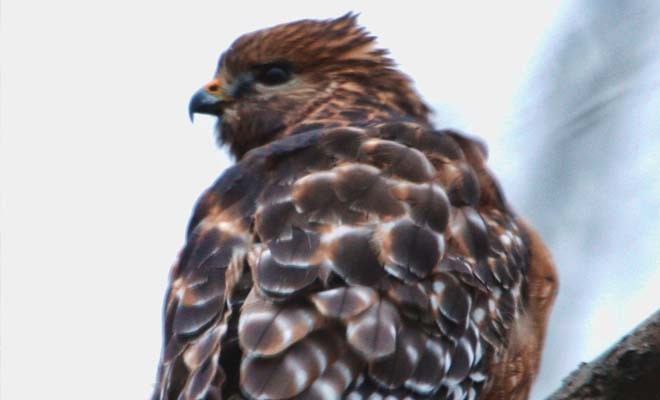
Phenology
“Their northward flight keeps pace with unfolding bud and expanding leaf. The sequences of nature, the timing of migration, are exact. Buds burst, new leaves unfurl, larvae hatch, and warblers appear.” – Edwin Way Teale, North with the Spring, 1951
As defined in the Merriam-Webster dictionary, phenology is “a branch of science dealing with the relations between climate and periodic biological phenomena (as bird migration or plant flowering).” Bohlen reports that 95 percent of the bird species in Sangamon County are migratory, and he notes that some of the more profound changes he has seen are related to the timing of migration. “I thought things were pretty static, that this came at that date, and this is what happens. But no, the whole picture changed,” he states.
Dr. Eric Grimm, the Director of Sciences and the person at the forefront of climate change research at the Illinois State Museum, claims that there are two items of particular note in Bohlen’s research, and both of these items refer to the value of data-supported knowledge. “It is no longer just anecdotal about how things have changed, and [Bohlen] gives the reasons why he thinks the changes have happened,” he states. “I think the value of this, for climate change study in particular, is the fact that it is baseline data for what we are seeing.”
In addition to changes in migration, Bohlen has also documented a shift of some species to the north, particularly the Blue Grosbeak and the Black-necked Stilt. “I think there was one Blue Grosbeak recorded before I started. Now they are fairly common in the summertime as a migrant,” he says. He also witnessed an increase in many geese populations. “The timing changed more than anything,” he adds.
So…birds are coming earlier, and we are now more likely to see the extraordinary Blue Grosbeak. Certainly this should be a bonus to central Illinois bird lovers. But, as observed by the American naturalist and Pulitzer Prize-winning writer Edwin Way Teale, the timing of migration is exact. The larvae must hatch and the plants must pollinate before the migrants arrive seeking these food sources. Disruption to a finely coordinated strategy that has evolved over millennia can mean starvation.
In addition, Grimm warns that shifts in species related to climate change will not occur as we might imagine. “One of the things we know from our studies of the past is that if big climate changes materialize as projected, the shifts are not always as you would expect.” He states that temperatures are getting warmer, despite the occasional plunges. Trends in temperature can only be understood through documentation over many years. And climate change, in fact, does not imply uniform warming. Years of increased temperatures can cause a disruption in ocean currents, which can, in turn, make temperate areas colder.
“You might expect that southern species will just move north. Or, if it gets colder, the northern species will just move south,” states Grimm. “But that’s not what happens. They move all over the place. And, the ecosystems that we have today will break up.”
To this Grimm adds the ongoing refrain. “So again, having this baseline data is really important.”
The power of knowledge
“Who is responsible for maintaining biodiversity? I would say the easy answer is everyone…Why have an impoverished and uninteresting biota, when we can have a diverse and fascinating one?” - H. David Bohlen
Bohlen takes me into the bird specimen room adjacent to his office where drawers are filled with tiny corpses and the shelves are lined with large, plastic-shrouded birds of prey. Bohlen notes he has added several thousand Sangamon County specimens to the collection since his arrival at the museum, although he is quick to clarify that the large majority had been killed on the roads or were causalities of transmission tower strikes.
I have to ask him – are there any Passenger Pigeons in the collection?
Bohlen opens another drawer to reveal the few specimens held at the museum. Here they are – the birds that are thought at one time to have been the most numerous bird species on the planet. Population estimates from the 19th century range from 1 billion to close to 4 billion individuals, but within only a few decades they became extinct, primarily from unrestrained hunting and the clearing of forests. The last remaining Passenger Pigeon died in captivity on Sept. 1, 1914. It is the ultimate cautionary tale.
The reminder of this great extinction is, in a way, the nudge needed to realize that the publication of Bohlen’s study, despite its dire implications, is good news for all of us. With knowledge comes awareness and power. Future extinctions need not occur. We have the ability to read the lyrical descriptions of Eifert and recall the recoveries wrought, in part, by Rachel Carson’s publication of Silent Spring. And we can study the report of Bohlen that, through the launch of the Illinois State Museum’s Research eSeries, is free and accessible to all.
Bonnie Styles, museum director, explains that the museum staff continues its work in an ever-changing environment. Therefore this new format will allow the museum to “easily update findings and present new versions as new discoveries are made.” Even prior to publication, Bohlen added three appendices to his report for data accumulated in the years 2010 through 2012. “I continue to monitor,” he states.
Bohlen’s report as well as The State of the Birds, United States of America, 2009 provide recommendations for governments and citizens alike in the hope of initiating actions that will reverse the current trends: protect existing preserves and create new ones, create green space in urban environments, landscape with native plants in backyards and parks, adopt architecture and lighting systems that reduce collisions. We can all play a role in supporting a diverse and fascinating world.
“Nature, natural habitat, biodiversity, whatever one wishes to name it,” states Bohlen “is one of those inalienable rights that everyone should be able to enjoy.”
Jeanne Townsend Handy of Springfield writes about nature and the environment. Contact her at www.jthandy.com.





